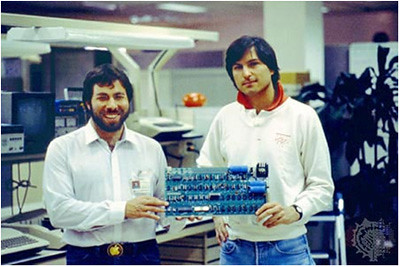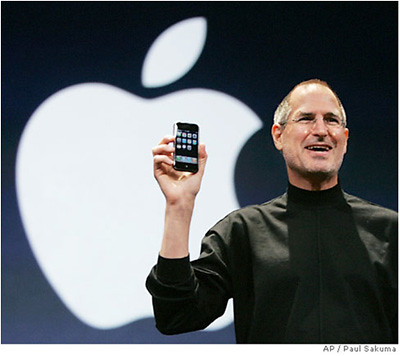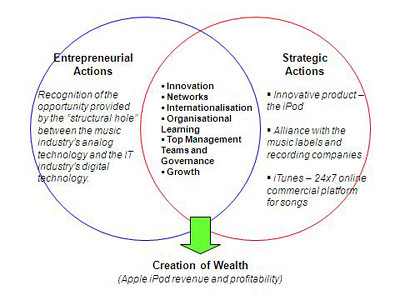... Continued from Part 2
4.0 Entrepreneurship Perspective
4.1 General
For the third perspective of our multi-perspective approach to strategic management, the Entrepreneurship perspective is chosen simply because for each and every business venture, entrepreneurship is necessary.
In Apple’s case, there is no lack of the entrepreneurial spirit and entrepreneurship in the form of Steve P. Jobs, the co-founder of Apple Inc.
Figure 4-1: Apple founders – Stephen Wozniak (left) and Steve Jobs, 1976

4.2 Definition of Entrepreneurship
Kuratko & Hodgetts define entrepreneurship as, “a dynamic process of vision, change, and creation. It requires an application of energy and passion toward the creation and implementation of new ideas and creative solutions. Essential ingredients include the willingness to take calculated risks – in terms of time, equity, or career; the ability to formulate an effective venture team; the creative skill to marshal needed resources; the fundamental skill of building a solid business plan; and, finally, the vision to recognize opportunity where others see chaos, contradiction, and confusion” (2007, p. 33).
Figure 4-2: Steve Jobs introducing the iPhone at MacWorld 2007

4.3 Perspectives of Entrepreneurship
The key perspectives related to the field of entrepreneurship are:
§ To create and increase wealth through profits from an enterprise
§ To develop the enterprise by utilizing the enterprise’s resources and competencies
§ To implement changes by adapting human wants, market situation and the environment
§ To develop innovation through the creation of new products and/or services through self-confidence and self-determination
§ To grow the enterprise through sales and income growth
§ To create jobs by developing job opportunities through entrepreneurial activities To develop positive values via corporate governance and corporate social responsibilities
(Yusof et al, 2005, p. 4)
4.4 Characteristics of Entrepreneurs
Every entrepreneur needs to possess four basic characteristics:
§ Understanding their roles
§ Capability
§ Motivation
§ Change agent
(Yusof et al, 2005, p. 5)
4.5 Integration of Entrepreneurial and Strategic Actions
From the Entrepreneurship perspective, Apple had successfully integrated entrepreneurial actions with the necessary strategic actions in order to realize the Apple iPod, and related iTunes services. Figure 4-3 shows the integration concept.
Figure 4-3: Apple’s integration of Entrepreneurial and Strategic actions

Adapted from Ireland et al, 2001, p. 51
4.6 Entrepreneurship Perspective and the 7C’s of Strategy
4.6.1 Context
Apple has always “Think Different” from its competitors and was a pioneer in understanding the external environment, for e.g. the needs of customers such as ease-of-use, and introduced the Macintosh with a leading edge graphical user interface (GUI) operating system and mouse that was easy to use and intuitive.
4.6.2 Competence
Apple, through the entrepreneurial leadership of Steve Jobs is able to continuously scan the environment for opportunities in the changing market environment and customer trends. It is this ability that enabled Apple to recognize the opportunity in the market between the traditional music industry based on analog music playback devices and digital music technology, resulting in the iPod and related iTunes services.
4.6.3 Corporate
Corporate Entrepreneurship (CE), defined as, “the process by which members of an existing firm bring into existence products and markets which do not exist within the repertoire of the firm” (Venkataraman et al, 1992, p. 488). Kuratko & Hodgetts defines CE as, “a process that can facilitate firms’ efforts to innovate constantly and cope effectively with the competitive realities that companies encounter when competing in international markets” (2007, p. 54). Apple Inc. began life as Apple Computer Co. in 1976. Since then Apple has ventured into the music industry with the iPod, and the telecommunications industry with the iPhone, each time introducing unprecedented innovation.
4.6.4 Competing
Establishing strong entrepreneurial network relationships with its partners enables Apple to gain more opportunities to achieve competitive advantage, for e.g. Apple is the only company licensed by the music labels and recording companies to offer for sale AAC -DRM encrypted digital songs as supporting services infrastructure to the iPod hardware.
4.6.5 Culture
Apple’s organizational culture promotes entrepreneurial behaviour (for e.g. close association with the market to understand customer needs) and innovation as evidence by their ability to introduce products that easily win over customers in terms of “cool” designs, functionality, and innovativeness.
4.6.6 Change
The entrepreneurial leadership of Steve Jobs has always embraced change by being the change agent, for e.g. Apple changed personal computing by enhancing it with a GUI-based operating system and use of the mouse. Apple changed the way people acquired, managed and enjoyed music with the iPod, creating a new “iPod Generation” paradigm.
4.6.7 Control
Entrepreneurial behaviour always strives for higher achievements and can result in bureaucratic controls and ways of doing things. Many articles have been written about Steve Jobs autocratic management style.
No two entrepreneurs are alike, and the unique entrepreneurial capability of Steve Jobs creates a unique competitive advantage for Apple Inc.
5.0 Conclusions
The Apple iPod phenomenon was discussed using three strategic management perspectives i.e. the Industrial Organisation, Network, and Entrepreneurship perspectives.
Collectively, the perspectives explains how Apple identified and developed new opportunities or markets, and attained competitive advantages over its competitors in the market segment of digital music entertainment although it was a late entrant to the market of MP3 devices and digital music.
The key aspects of each perspective contributing to the iPod phenomenon are summarised as follows:
a) Industrial Organisation – The behavior of Apple in the market structure in how it developed and gained market power and performance.
b) Network – Apple’s ability to develop a business ecosystem for the iPod and capitalise on the ecosystem to establish competitive advantages against competitors.
c) Entrepreneurship – The entrepreneurship capabilities of Steve Jobs, and the successful execution of the relationships between entrepreneurship and the seven C’s of strategy.
The critical perspective for Apple to become so successful with the iPod is Entrepreneurship. It is the entrepreneurial ability of Steve Jobs that makes him the visionary, the driving force, and the master innovator of Apple Inc. (Andrews, 2009; Lyons, 2009) to be able to utilize and capitalize on Apple’s resources and core competencies for three critical times in the history of Apple Inc. i.e. the introduction of the Macintosh personal computer in 1984, the iPod in 2001, and the iPhone in 2007 – each a key turning point in Apple’s fortunes, business continuity, and innovation leadership.
To most people in the ICT and related industries, Steve Jobs is not an ordinary person. His extraordinary dreams, which solicited doubts from others, have always been his driving force since his youth, for e.g., he believed that computers should be tools for everyday people at the time (pre-1975) when computers were very complicated and expensive, and huge, requiring the space of several rooms. Few ordinary people could afford or knew how to use a computer then.
User friendly point and click using a mouse device PCs or gorgeous looking PCs with highly intuitive graphical user interface operating systems, super thin notebooks, tablets, portable digital music players, low-priced music downloads, touch screen mobile phones, and digitally animated movies may not have existed or become so popular and desired if not for the dreams of Steve Jobs.
He is not a person that is easily understood due to his many sides. He has been described as charming, egotistical, brilliant, opinionated, charismatic, stubborn, persuasive, critical of others, and even mysterious. Although he is not the actual inventor of all those products, his bold visions, his passion for technology and design, his love for the job, and ability to motivate and inspire others made the creation of those products possible, and in turn created the market demand.
When he and Steve Wozniak started Apple in 1976, many people did not take them seriously because they were too young and inexperienced. They had no money and no office. Four years later, at 25, Steve Jobs was worth over USD200 million. By 30, after losing his job at Apple, he started another company – Next, and later bought Pixar. In 1997, Apple, at the brink of bankruptcy, brought Steve Jobs back, and in a short time made Apple more successful than ever.
However, Steve Jobs’ health issues have been causing concern among its shareholders and Wall Street, should he be unable to continue leading Apple Inc. (Helft, 2011; Can Apple Thrive, 2011; Lohr, 2011; Kane, 2009; Wagner, 2009). This is in part due to Apple’s silence on its key management succession plans (Apple succession call, 2011; Apple board to, 2011; Ante and McGregor, 2009). The multi-billion dollar question is, “Can Apple successfully carry-on without Steve Jobs’ extraordinary vision, passion, innovativeness, leadership and competitiveness?”
References
Ampikaipakan, Umapagan. (2011, March 8). “Steve Jobs is the Apple of IT industry’s eye.” New Straits Times, p. 17
Andrews, Amanda. (2009). “Steve Jobs, Apple's iGod: Profile.” Telegraph.com, January 14. Downloaded from http://www.telegraph.co.uk/scienceandtechnology/technology/apple/4242660/Steve-Jobs-Apples-iGod-Profile.html as at 27 February 2009
Ante, Spencer E. & McGregor, Jenna. (2009). “Apple Succession Plan: Nobody's Business?” BusinessWeek.com, January 15. Downloaded from http://www.businessweek.com/print/technology/content/jan2009/tc20090115_863327.htm as at 12 March 2009
Apple Annual Report 2008. Apple.com. Downloaded from http://www.apple.com/investor/ as at 9 April 2009
Apple board to face investors on Jobs succession. (2011, February 24). Star, p. B9
Apple succession call nixed. (2011, February 25). Star, p. B10
Apple using iPhone to play AT&T against Verizon? (2009, April 30). New Straits Times, p. B13
Boffey, Daniel (2008). “Apple admit Briton DID invent iPod, but he's still not getting any money.” MailOnline, September 8. Downloaded from http://www.dailymail.co.uk/news/article-1053152/Apple-admit-Briton-DID-invent-iPod-hes-getting-money.html?ITO=1490 as at 9 April 2009
Burrows, Peter. (2007). “Welcome to Planet Apple.” BusinessWeek.com, June 28. Downloaded from http://www.businessweek.com/technology/content/jun2007/tc20070627_285624.htm?chan=technology_technology+index+page_top+stories as at 1 May 2009
Burt, Ronald S. (1995). Structural Holes: The Social Structure of Competition. Cambridge , CA Harvard University
Buskirk, Eliot van. (2005). “Introducing the world's first MP3 player.” CNet.com, January 21. Downloaded from http://reviews.cnet.com/4520-6450_7-5622055-1.html as at 9 April 2009
Buskirk, Eliot van. (2007). “Creative Sells 25 Millionth MP3 Player, Focuses on Headphones Too.” Wired.com, November 14. Downloaded from http://www.wired.com/listening_post/2007/11/creative-sells/ as at 9 April 2009
Can Apple Thrive Without Its Visionary CEO? (2011, January 25). Star, In-Tech, p. IT15
Cohen, Peter. (2007). “Apple: 100 million iPods sold, and counting.” Macworld.com, April 9. Downloaded from http://www.macworld.com/article/57233/2007/04/ipodmilestone.html as at 9 April 2009
Cross, Rob; Hargadon, Andrew & Parise, Salvatore. (2005). “Critical Connections: Driving Rapid Innovation with a Network Perspective.” The Network Roundtable at the University of Virginia. Downloaded from https://webapp.comm.virginia.edu/NetworkRoundtable/Portals/0/Networks_and_Innovation_Roundtable_final.pdf as at 9 April 2009
Dalrymple, Jim; Seff, Jonathan & Michaels, Philip (2009) “Apple reports record profit for first quarter.” Macworld.com, 22 January. Downloaded from http://www.macworld.com/article/138362/2009/01/earnings.html as at 9 April 2009
Dimkovic, Ivan. (2001). “Improved ISO AAC Coder.” Downloaded from http://www.mp3-tech.org/programmer/docs/di042001.pdf as at 9 April 2009
Eisenbach, Regina
Fortune: World’s Most Admired Companies 2009. (2009). CNNMoney.com. Downloaded from http://money.cnn.com/magazines/fortune/mostadmired/2009/index.html as at 9 April 2009
Harvey, Arlene. (2001). “A dramaturgical analysis of charismatic leader discourse.” Journal of Organizational Change Management, Vol. 14, No. 3, pp. 253 – 265
Hau, Louis. (2007). “Taking on the iPod.” Forbes.com, September 11. Downloaded from http://www.forbes.com/2007/09/11/apple-sandisk-ipod-tech-personal-cx_lh_0911sandisk.html as at 22 March 2009
Helft, Miguel. (2011, January 31). “Filling Steve Jobs' Shoes.” New Straits Times, Life and Times, p. 15
Herre, J. & Dietz, M. (2008). “MPEG-4 high-efficiency AAC coding [Standards in a Nutshell].” IEEE Signal Processing Magazine. Vol. 25, No. 3, pp. 137 – 142. Downloaded from http://ieeexplore.ieee.org/Xplore/login.jsp?url=http%3A%2F%2Fieeexplore.ieee.org%2Fiel5%2F79%2F4490183%2F04490211.pdf%3Farnumber%3D4490211&authDecision=-203 as at 9 April 2009
Hesseldahl, Arik. (2009). “Apple's Impressive Quarterly Numbers.” BusinessWeek.com, January 22. Downloaded from http://www.businessweek.com/print/technology/content/jan2009/tc20090121_101972.htm as at 12 March 2009
Hesseldahl, Arik. (2009). “Tim Cook: A Steady Go-To Guide for Apple.” BusinessWeek.com, January 14. Downloaded from http://www.businessweek.com/print/technology/content/jan2009/tc20090114_965277.htm as at 12 March 2009
Hodgkinson, Gerard P. (2007). “The Cognitive Perspective” in Jenkins, Mark & Ambrosini, Veronique, with Collier, Nardine (Eds.), Advanced Strategic Management: A Multi-Perspective Approach, 2nd Edition, pp. 151 – 172. New York , NY
Hormby, Tom. (2007). “’Think Different’ – The ad campaign that restored Apple’s reputation.” LowEndMac.com, April 9. Downloaded from http://lowendmac.com/orchard/07/apple-think-different.html as at 9 April 2009
In from the cold: How Apple has blossomed. (2008). Strategic Direction, Vol. 24, No. 3, pp. 13 – 16
iPhone and iPod sales make it a fruitful quarter for Apple. (2009, April 24). The Star, p. B10
Jobs, Polet & Gunn. (2008). “Leading Personalities.” Strategic Direction, Vol. 24, No. 11, pp. 17 – 19
Kane, Yukari Iwatani. (2009). “Apple's Jobs Takes Medical Leave.” The Wall Street Journal.com, January 15. Downloaded from http://online.wsj.com/article/SB123196896984882901.html as at 27 February 2009
Kuratko, Donald F. & Hodgetts, Richard M. (2007). Entrepreneurship: Theory, Process, Practice, 7th Edition. Mason , OH
Levine, Dan. (2001). “Apple Unwraps iPod.” Forbes.com, October 24. Downloaded from http://www.forbes.com/2001/10/24/1024tentech.html as at 27 February 2009
Levy, Steven. (2006). The Perfect Thing: How the iPod Shuffles Commerce, Culture, and Coolness. New York , NY
Linzmayer, Owen W. (2004). Apple Confidential 2.0: The Definitive History of the World’s Most Colorful Company. San Francisco, CA: No Starch Press
Lohr, Steve. (2011, January 24). “What next for Apple? As co-founder and CEO Steve Jobs goes on medical leave, can Apple find more hits?” New Straits Times, Life and Times, pp. 8 and 25
Lyons, Daniel. (2009). “Steve Jobs: The ailing creator of the iPod and iPhone is next to irreplaceable.” Newsweek.com, January 5. Downloaded from http://www.newsweek.com/id/176318 as at 27 February 2009
MacMillan, Douglas. (2009). “The Music Industry's New Internet Problem.” BusinessWeek.com, March 6. Downloaded from http://www.businessweek.com/print/technology/content/mar2009/tc2009035_000194.htm as at 6 March 2009
Malone, Michael S. (1999). Infinite Loop : How Apple, the World’s Most Insanely Great Computer Company, Went Insane. London , England
Michaels, Philip & Moren, Dan. (2006). “Live Update: Apple 4Q financial report.” Macworld.com, October 18. Downloaded from http://www.macworld.com/article/53456/2006/10/q4analysts.html as at 9 April 2009
New iPod maker signed. (2004). Macworld.co.uk, May 12. Downloaded from http://www.macworld.co.uk/news/index.cfm?NewsID=8666 as at 9 April 2009
Porter, Michael E. (2008). “The Five Competitive Forces That Shape Strategy.” Harvard Business Review, Vol. 86, No. 1, pp. 78 – 93
Rao, Venky. “Innovation Networks: Harnessing the Power of Ecosystems to Transform Organizations.” Insights White Paper. Satyam.com. Downloaded from http://www.satyam.com/about/documents/satyam_wp_innovNetw.pdf as at 9 April 2009
Reeves-Ellington, Richard H. (1998). “Leadership for socially responsible organizations.” Leadership and Organization Development Journal, Vol. 19, No. 2, pp. 97–105
Rickard, Sean. (2007). “Industrial Organisation Economics Perspective” in Jenkins, Mark & Ambrosini, Veronique, with Collier, Nardine (Eds.), Advanced Strategic Management: A Multi-Perspective Approach, 2nd Edition, pp. 61 – 82. New York , NY
Sarkar, Soumodip. (2007). “Sustaining Leadership: Alice 9 April 2009
Sharpe, Nicola F. & Arewa, Olufunmilayo B. (2007). “Is Apple Playing Fair? Navigating the iPod FairPlay DRM Controversy.” Northwestern Journal of Technology and Intellectual Property, Vol. 5, No. 2.
Strong iPhone sales propel Apple to record best Q2. (2009, April 24). New Straits Times, p. B13
Svejenova, Silvija & Alvarez, Jose Luis. (2007). “Network Perspective” in Jenkins, Mark & Ambrosini, Veronique, with Collier, Nardine (Eds.), Advanced Strategic Management: A Multi-Perspective Approach, 2nd Edition, pp. 185 – 195. New York , NY
The Third Act. (2007). Economist.com, June 7. Downloaded from http://www.economist.com/opinion/displaystory.cfm?story_id=9298983 as at 26 June 2007
Venkataraman, S.; MacMillan, I. & McGrath, R. (1992). ”Progress in Research on Corporate Venturing” in Sexton, Donald L. & Kasarda, John D. (Eds.), State of the Art in Entrepreneurship, pp. 487 – 519. Boston , MA
Wagner, Mitch. (2009). “Where Does Apple Go From Here?” InformationWeek.com, February 21. Downloaded from http://www.informationweek.com/news/hardware/mac/showArticle.jhtml?articleID=214501912 as at 12 March 2009
Wikipedia – iPod. Wikipedia.org. Downloaded from http://en.wikipedia.org/wiki/Ipod#Sales as at 9 April 2009 and 18 February 2011
World’s Most Innovative Companies 2009. (2009). BusinessWeek.com, April 9. Downloaded from http://www.businessweek.com/magazine/toc/09_16/B4127innovative_companies.htm as at 9 April 2009
World’s Most Innovative Companies 2009. (2009). FastCompany.com. Downloaded from http://www.fastcompany.com/fast50_09 as at 9 April 2009
World’s Most Innovative Companies 2007. (2007). BusinessWeek.com, May 4. Downloaded from http://www.businessweek.com/innovate/di_special/20070503mostinnovat.htm as at 9 April 2009
Woyke, Elizabeth. (2008). “iPod Battle Rage On.” Forbes.com, July 31. Downloaded from http://www.forbes.com/2008/07/31/mp3-ipod-samsung-tech-pers-cx_ew_0731mp3.html as at 22 March 2009
Yahoo! Finance – AAPL . Finance.Yahoo.com. Downloaded from http://finance.yahoo.com/q?s=aapl as at 6 May 2009
Young, Jeffrey S. & Simon, William L. (2005). iCon Steve Jobs: The Greatest Second Act in the History of Business. Hoboken , NJ
Yusof, Abdul Aziz; Perumal, Selvan & Pangil, Faizuniah. (2005). Principles of Entrepreneurship. Petaling Jaya, Selangor: Pearson Prentice-Hall